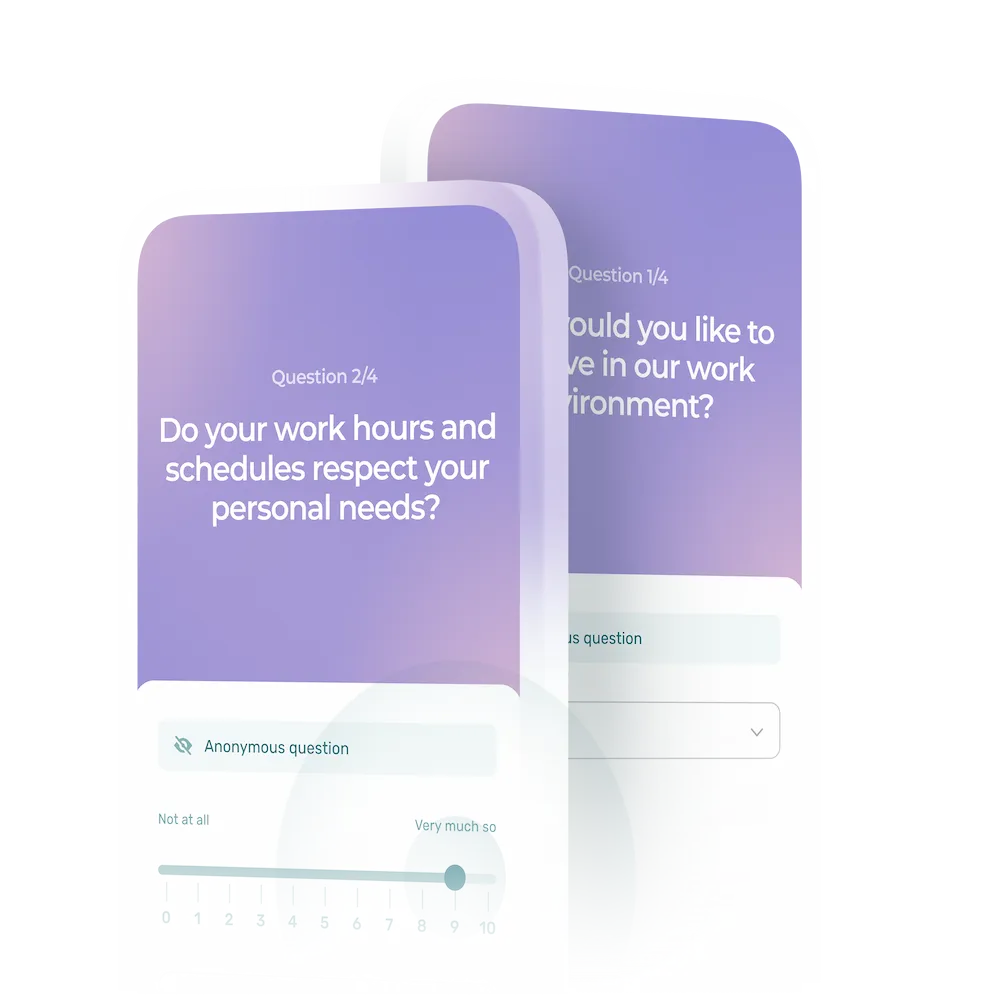Since July 2022, the phenomenon of quiet quitting has garnered more and more coverage in the news. But what is it and what can you do about it as a manager?
Quiet quitting is when an employee simply does the bare minimum required of them at work. In other words, they only do the tasks that they’ve been assigned, without ever going beyond the expectations of their employer.
This post introduces you to the concept, the difference between quiet quitting and presenteeism, and a few tips on how to find out if people at your organization may be quiet quitting.
What Explains This Wave of Quiet Quitting?
Employees are often driven to practice quiet quitting when they feel that their personal and professional lives are out of balance. It’s no coincidence that this movement gained traction during the COVID-19 pandemic!
During lockdowns, while stuck at home and removed from their everyday routines, people had a lot of time to think about their lives, their dreams and their ambitions. Many questioned everything from their relationship to work to their entire life purpose.
For most people, work is an important part of their identity, alongside their gender, orientation and religion. The portion of our identity connected to work is rooted in a culture of meritocracy, in which individuals are valued on the basis of merit, for example through their job or academic success. This is why holding an important position at a reputed company or working crazy weeks can be a source of pride and prestige—even when it’s at the expense of your personal life.
But when everything came to a standstill in March 2020, people realized just how valuable their time really is. What’s the point of spending so many hours of your life in a job that barely covers your expenses and where you don’t feel appreciated by your employer?
Trading in the Culture of Overwork for a Balanced Life
It’s as if something clicked in many people’s minds and they instantly unsubscribed from the culture of workaholism. These people decided to do only the bare minimum that their job requires of them.
Quiet quitters don’t necessarily want to quit their jobs—although sometimes they do. What they usually want is to enjoy life and consider work as just one part of it rather than the most important thing.
Work to live > Live to work
Quiet Quitting to Highlight Workplace Injustices
For some workers, quiet quitting is more of a statement of their dissatisfaction and disengagement. They don’t feel that their work is recognized at its true value. So they stop going beyond their employer’s expectations, to express their indignation.
Is There a Link Between Quiet Quitting and the Great Resignation?
The Great Resignation is a phenomenon that also emerged in 2021 in the USA, during the COVID-19 pandemic. It refers to the wave of employees who decided to quit their jobs in order to find better ones.
The most common reasons for these mass resignations included stagnant wages in a context of booming inflation, few or no career advancement opportunities, toxic work environments, lack of flexibility for work-family balance, and lack of employee recognition from employers.
Quiet quitting and the great resignation are not the same thing. But they do both reflect the current state of the labor market, in which employees are fed up with poor working conditions and are taking action to make their voices heard.
Following the Great Resignation: the art of doing the bare minimum at work.
In the case of quiet quitting, employees stay on the job but do the least that’s required of them, while in the great resignation, employees leave their current job to work in another field or for another employer.
Quiet Quitting and Presenteeism: Same Difference?
If the great resignation is the aunt of quiet quitting, presenteeism is the big brother.
Quiet Quitting
There are generally two personas of quiet quitting employees:
- Disengaged employees who are looking for a new job, and who end up quitting their current job to find it.
- Employees who remain engaged in their work, but who refuse to go the extra mile to exceed expectations. Their priority is their personal life.
Presenteeism
Presenteeism means being physically present at work but without meeting the expected level of productivity. In other words, doing less than the minimum required. Presenteeism can be traced back to personal reasons (illness, personal problems, etc.) or work-related reasons (demotivation, conflicts, lack of recognition, overload, etc.).
There are several types of presenteeism:
- Strategic presenteeism: arriving early in the morning and staying late at night in order to look good at work and feign motivation.
- Contemplative presenteeism: showing up for work but doing anything except the work and tasks required by the employer.
- Over-presenteeism: working even in spite of a health condition that calls for a sick leave. In France, over-presenteeism can also refer to unpaid overtime—a completely different matter.
As you may have guessed, quiet quitting and presenteeism are both very harmful and costly for a company.
How Can You Know if Your Employees Are Quiet Quitting?
These theoretical concepts are all well and good, but how can they be addressed concretely? Let’s start by identifying behaviors that may suggest an employee is quiet quitting or engaging in presenteeism.
- Refusing to help out coworkers: sticking to individual tasks and refusing to support colleagues when necessary, for example, during busy periods.
- Following the schedule to the exact minute: always starting and finishing shifts exactly on time, even if the employee’s help may be needed for a few extra minutes.
- Showing lower engagement and motivation: being less thorough or failing to complete tasks.
- Refusing to do tasks that aren’t in their contract: keeping to the letter of the employment contract, without considering the context or the team’s workload.
- Turning down invitations to team activities: never taking part in social activities organized by the company.
- Refusing to do overtime: while all employees have a right to refuse overtime, this can also be an indicator of disengagement, depending on the context.
⚠️ Note that the above behaviors are only examples and that various factors such as the context, the employee’s health, and other factors should always be considered in order to avoid a hasty diagnosis.
Playing Devil’s Advocate: Is There a Good Side to Quiet Quitting?
It may be easy to judge employees who resort to quiet quitting. But you also have to walk a mile in their shoes.
Is it normal to require workers to work overtime every week? To give them a workload that exceeds their capacities? To take their engagement and motivation for granted, because they get paid in return?
Let’s take a good look in the mirror. If employees are quiet quitting, it may be because they need to be listened to. Maybe they’re overwhelmed. Or on the contrary, maybe they don’t have enough responsibilities and are disengaging out of boredom!
They may be going through a rough patch at home, or they may have simply chosen to spend more time with their families. And who can blame them?
The Shift to a More People-Centred Market
The labor shortage is here to stay. Employers who are able to set themselves apart will be able to retain their staff and will even have an easier time recruiting new employees.
As the labor market continues to shift, so must staff-management practices. The time has come to move to more people-focused management that takes into account worker needs.
This is precisely our vision at Agendrix: A world where each and every worker feels valued and is able to lead a balanced life.
And What About the Managers’ Role?
For a manager, quiet quitting can be an opportunity to improve HR practices and better get to know their team. The idea here is not to make anyone feel guilty, but to foster awareness: your impact on your team’s health may be greater than you think.
There are solutions to tackle quiet quitting, presenteeism and disengagement:
- Offering more flexibility, for example with adapted or rotating schedules
- Showing employee appreciation for their work
- Prioritizing employee well-being
- Restoring trust with the team
- Giving employees the means to better manage their stress
- Being a good listener, especially during one-on-one meetings
- Analyzing and adapting staff management practices
All of these avenues can help build a healthy work environment where employees can find fulfilment and develop to their full potential.
Agendrix offers several solutions to support you in this respect, including a survey module to check in on your team, an employee recognition tool, and an onboarding module to streamline the process of welcoming and integrating new employees.
To conclude, I’d like to leave you with a quote that I’ve always found inspiring:
CFO asks CEO: “What happens if we invest in developing our people and then they leave us?”
CEO: “What happens if we don’t, and they stay?”










